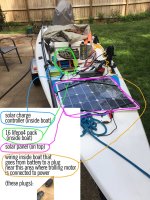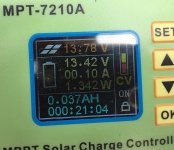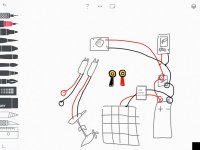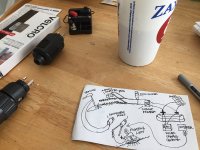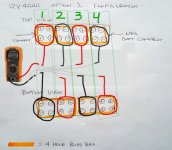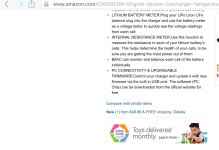what is correct full charge of a lifepo4 12V40ah cell
GWL/Power Lithium Battery 12V/90Ah
http://www.ev-power.eu/LiFeYPO4-batteries-12V-1-1/Lithium-Battery-12V-90Ah-WB-LP12V90AH.html?cur=1
LP = 12V Battery block
LFP = 3,2V Cell (4 x 3,2= 12,8V) needs BMS (Battery Management System) for monitoring and balancing of the individual cells.
Minimum Volt: 2,5V per cell = 10V
Recommended minimum discharge: 2,75V = 11V
Maximum Volt: 4V per cell = 16V
Recommended maximum charge: 3,65V = 14,6V
Nominal Voltage: 3,2V = 12,8V
After Full Charge the voltage will drop back to 12,8-13,6V
The Float voltage for the LiFeYPO4 batteries
Unlike the lead acid batteries, there is no need for lithium batteries to apply the constant voltage to maintain the cells in a fully charged condition. (Typical for lead acid batteries 12V - Gel 13.05V, Flooded 13.4V and AGM 13.6V values @ 25°C).
In case you replace the lead acid battery with the LiFeYPO4 battery, it is good to check how the device behaves when charging the battery. When applying the unmanaged float voltage (all called trickle charge), the voltage for LP 12V battery should be always bellow 14.4V (3.60V x 4 cells). Simply said the AGM value of 13.6V should be always OK with the LP batteries / LFP cells.
Depth of discharge (DOD)
All battery manufacturers recommend to keep the Depth of Discharge (DOD) bellow the maximal limit of 100%. Ideally 80% DOD or less is recommended. The rule is quite simple: the smaller DOD the larger number of cycles. With 50% DOD the LiFePO4 cells may have well above 5000 cycles. However it is imporatnt to keep the DOD at the cetral part of the capacity range. If the DOD is not in the center of the capacity range, the cell performace may degrade faster.
As a matter of fact, since it is better to avoid deep cycle discharging, it seems to be better to charge as frequently as possible. It is better to “charge (to full) and drive” rather than “drive and charge (from null)”.
FAQ: 12V LP battery balancing and charging
Question: Can I charge the 12V LFP battery using a conventional auto-moto charger 12V?
Answer: With most of “cheap” car battery chargers you cannot charge the 12V LFP battery. Cheap chargers often end charging at 14V. As a result the LFP batteries are not charged sufficiently. In order to charge to full you need to reach above 16V.
If you have an “advanced” manageable charger, it can be used provided you can set the charge level to at least 16V.
Simply said: you can charge with any kind of charger if you make sure that the battery voltage reaches at least 16V, but does not exceed the maximum limit of 17V.
Question: What are the experiences of balancing 12V batteries, when, for example, four pieces of 12V/40Ah in the series?
Answer: Unlike 3.2V cells that can hardly be operated without balancing, the 12V LP batteries behave “very sophisticated”, so the need for continuous balancing practically does not exist. It is just enough to check the voltage levels during inspection periods. If you notice a difference in the battery voltage levels, we recommend balancing all batteries manually to the same maximum charging level (ie, max 17 V / per battery).
Such manual balancing is made after recharging cells in series, connecting the single battery charger (for 17V) to each individual battery.
The inspection periods and manual balancing is recommended to be performed in these intervals (ie, after number of discharge / charge cycles):
During the initial charge
After the first cycle
After the first 5 cycles
After the first 20 cycles
After the first 50 cycles
And then continue any time differences between batteries are noticed, about once every 50 to 200 cycles.
Question: How should new batteries 12V 20Ah, 40AH, 80 AH, 100 AH, etc. be formed before first usage?
Answer: The new 12V LP batteries delivered from the warehouse are partially charged. However before the first use, it is essential to charge the battery to full capacity. The initial charging should be done with the charging current set to less than 1C (typically 0.5C), till the voltage level of 17V is reached.
There is no other need for LP 12V batteries to be formatted or otherwise specially prepared for the use. After the first charge to full, the battery is ready to be used for use.
The above charging rule is also applied to the initial charge after the battery has been unused or stored for a long time. If not used more than 1 month, it is recommended to make again an initial charge to full.
Important: if you plan not to use the batteries for a long time, before storing you must charge batteries to full. In the case of storage longer than 1 year, it is required to recharge each battery after 12 months to full.
FAQ: Simple balancing using parallel connection
Question: Can I balance the cells by simply connecting all the batteries in parallel?
Answer: You can do this, but it will not work effectively. Actually you would need a long, long time (days or weeks) to balance the batteries this way. Effectively said: you can parallel the batteries if you want them all to discharge to the same voltage level over a period of time.
However you cannot think this way: if you have one 100% fully-charged and one 0%-charged battery and you connect them parallel you will get two 50% charged batteries over some time. It does not work this way!
First: never connect charged and discharged batteries together. Neither in serial nor in parallel. Use only batteries charged to the same voltage level.
Second: you cannot charge a battery using another battery as a charger. You need a charger to charge. You cannot use a battery to charge another battery. The reason: you need to have a higher potential (voltage level) to charge the battery.
FAQ: Using LiFePO4 batteries as starting batteries for the fuel cars
Q: Can the 12V LFP/LFYP batteries be used as starting batteries for the regular vehicles?
A: Yes. We highly recommend using the LFP/LFYP batteries for starting vehicles. Their performance is much better than the lead-acid batteries.
Q: What are the advantages of the LFP/LFYP batteries?
A: LiFePO4 batteries are able to provide much higher starting current than the lead-acid batteries (SLA). They work even in extreme low temperatures (bellow –35 deg. C). They cannot “get frozen” like SLA batteries. They contain no acids and require no special care. Their life span is 10 years and more, while SLA batteries may last just 4 to 5 years. There are no known disadvantages when using LFP/LFYP batteries.
Q: Which battery model is sufficient to start a normal gasoline car?
A: LP 12V 40Ah is sufficient for any range of starting batteries up to 65 Ah of the original lead acid value. For vehicles with larger battery we recommend LP12V 100Ah. For trucks and machinery (using 24V system) we recommend 2 pcs of LP12V 100Ah connected in serial. For campers, mobile homes and other vehicles with large battery we suggest to use 12V 200Ah, by connecting two 100Ah batteries in parallel.
Q: What are the limitations when using the 12V LFP/LFYP batteries in cold winter season?
A: There are no limitations. The 12V LiFePO4 batteries perform very well under low temperatures. We highly recommend to replace the SLA battery with LFP especially if your vehicle is parked out-side and gets very cold. The 12V LFP/LFYP batteries are ideal for countries like Canada, Scandinavian lands, Russia – Siberia, and other cold regions.
FAQ: Using LiFePO4 batteries as starting batteries for the fuel cars (2)
Q: How will the LiFePO4 battery be affected by the charging system of the car?
A: The 12V LiFePO4 battery is not affected by the charging system at all. Majority of the cars’ charging systems charge up to 14V or 14.4V. This represents the charging level of 70% to 75% for the LFP batteries.
Q: Will the car charging system overcharge the LFP battery and shorten its life?
A: No. The overcharge for LFP battery is above 17V. There is no way to reach this voltage in the vehicle. As the LFP battery has no memory effect, it can be charged any time to any capacity. There is no shortening of the life-span when using as a starting battery.
Q: What is the starting time for the fuel engine when using 12V LiFePO4 battery?
A: The starting time for any fuel engine is given by the vehicle manufacturer. Usually it is about 5 to 10 seconds. This time is the same for LFP battery. In any case, the fuel engine should not be started with long starting attempts. Please see the vehicle instruction for starting the engine.
Q: What is the max current available from the 12V LFP battery?
A: The 12V LiFePO4 battery can release the energy very quickly without any limitation. The peak short connection current may reach above 1000A. Unlike lead-acid batteries that are limited by the Peukert’s law(http://en.wikipedia.org/wiki/Peukert’s_law), the LFP batteries do not have any such limitation. However due to the high energy release, the LFP batteries should not be extremely discharged for longer than 10 seconds.
The discharge table for 12V 40Ah LP LiFePO4 battery
20 A current - min. 120 minute use (2 hours)
40 A current - min. 60 minute use (1 hour)
60 A current - min. 40 minute use
200 A - max 10 s. peaks - approx 70 times (7010s = 700 s. ~ 12 minutes)
400 A - max 10 s. peaks - approx 35 times (3510s = 350 s. ~ 6 minutes)
1000 A - max 5 s. peaks - approx 18 times (18*5s = 90 s ~ 1.5 minute)
FAQ: What is the charging voltage of the 12V battery? 16V or 14.4V?
Question: Some web pages and the GWL blog says that the final voltage of the charge for 12 LP battery is 16V. But some other pages and some charger specifications give information about charging to 14.4 ~ 14.6V. What is the difference?
Answer: The maximal charge voltage for the LiFePO4 technology is 4.00 per cells (16.00V per battery). This is the recommended charge voltage for the initial charging to balance all the cells to the same full level. Check the explanation here.
However for the long term use it may be better not to charger to full, but to charge to a lower voltage to get the maximal life-span. For example charging to 3.65V per cell is considered to be around 85% charge. It works very well for 1000, 2000, 3000 and more cycles. That is why some of the chargers (example the TC-Charger models) charge only to 3.65 V per cell (14.6V per battery). See the additional information at this post.
You must charge before the first use!
We remind all users of the LFP cells and LP batteries that the cells and batteriesMUST be charged to full voltage level BEFORE assembling into a pack and before starting to be used.
For the 3.2V cells, the full charge voltage level is 4.00V and the charging isdescribed here. For the 12V LP batteries the full charge voltage level is 16.00V. More details about the use of 12V batteries is here. (Check also the section about the 12V LP batteries)
Even in simple installations, it is important to make the first charging. Example: when assembling a 48V pack using 4 pieces of 12V batteries, it is very important to charge all batteries to the same voltage (16V) before assembling the whole pack. Only after the batteries have been balanced to the same voltage level, it is possible use them as a pack and to charge the whole pack together using the 48V charger.
Please remember: FIRST CHARGE, THEN USE!
FAQ: Can LiFePO4 cells be charged with impulse DC current? (Most lead-acid batteries prefer to be charged with trickling currents – which increases their lifespan.)
Answer: With LiFePO4 cells it is possible to charge with non-impulsive DC current. There is no study or a test report known to us that would show any advantages of impulse current charging against the standard flat current charging. Based on comments from LFP cells suppliers, as far as possible the cells should be charged with continuous (non-impulsive) DC currents.
FAQ: Do we need to install a temperature sensor to monitor the charging of the cells?
Answer: Certainly it is wise to install temperature sensors as secondary protection during the cells operation. Each cell should have its own sensor. During the standard operation all cells should have identical temperature corresponding to the temperature of the surrounding environment. The LFP cells do now get significantly warm during regular operation (standard charge/discharge at 0.5C and less).
If the temperature sensors show a temperature difference of one or more cells (even if the difference is just a few degrees), it is suggested to inspect the operation of such cells to find out the reason for the temperature increase. It is to better to locate a possible problem before the cells may get damaged for some reason.
Q: Please explain how you can charge a cell to 4.00V volt. And why some people suggest charging to 3.65 Volt.
We recommend to reach 4.0V for the initial charge. The 3.65V is a usual charging level for the regular operation of the cells. This means after you make the initial charge to 4.00V you continue to use the cells and charge to 3.65V (or 3.80V or some similar level) for the regular operation. Simply said charging to a lower level will extend the cell’s total life span (in number of cycles).
FAQ: Can I connect a charger permanently to the battery?
Such connection is not recommended and may not work properly. There are several reasons.
The danger of deep discharge of the battery after the charging is finished.Most chargers have some minimal consumption when connected to the battery. If the charger is left connected for a long period of time, the charger may discharge and deplete the battery completely.
Need to reconnect to resume function. Most chargers need to reconnect to resume the charging function. If the charger is connected permanently it will not resume charging unless the terminals are disconnected for some time and connected again.
The danger of an accident. The charger’s electronic may not be designed to be permanently connected to the battery if not charging any longer. After some time some components may overheat or become defective. In any case, we always recommend having proper fusing and disconnection option for any cabling connected to batteries. This allows disconnecting the batteries in case of an accidental short circuit connection or malfunction.
An idea: to allow repeated charging of batteries without the need for manual reconnection, the hint may be to use some timer device that will connect the batteries to the charger to allow the charging. However again we give the warning, that any battery charging must be properly monitored by a human operator.
FAQ: Can a battery be charged when being discharged?
Answer: If the charging current is higher than the discharge current, it is possible to charge the battery when being under load. When charging the charging current will be first consumed by the load and only the current in extra will be used to charge the battery: Example: the discharge current is 4 Amps, the charging current is 5 Amps. The effective charging for the battery will be the difference: 1 Amp.
FAQ: Replacing the SLA batteries
I want to replace the lead acid 12V 100Ah stating battery. Which LFP model can I use?
Answer: The performance of the LFP batteries concerning the starting current is excelling the performance of the SLA (lead-acid) batteries. Our tests and the tests of our customers show that the LP12V 40Ah battery can replace any SLA starting battery (even the 100AH, or 150 Ah models). Even big diesel machines can be started from the LFP battery at very cold weather.
For long term use and massive deployment, we suggest to make testing for each application to make sure that the replacement LFP battery will work properly for long time.
FAQ: charging multiple 12V batteries
FAQ: Can I charge multiple 12V batteries in series at the same time with one charger? (i.e. 2 batteries for 24V, 3 batteries for 36V, etc…)
Answer: Yes, it is possible to charge a battery pack consisting of multiple 12V batteries in series at the same time using one charger. However following needs to be observed:
The initial charge – you need to charge all the 12V batteries individually to full voltage level BEFORE you start using them together as a pack.
We strongly recommend to use some kind of management to make sure all the batteries are working within the proper operating voltage levels. For examplethe Akumon may be used to monitor the status of the batteries.
Additionally we remind the need to observe the general instructions concerning the use of the 12V batteries.
FAQ: Which to use: the 12V LP batteries or the 3.2V single cells?
Answer: Single cells built into packs with BMS allow for a deeper cycle, and faster charging and discharging cycles, as it is possible to charge/discharge the pack according to the lowest voltage of the cell in the pack (the weakest cell).
The “mono block” 12V LP batteries should not go deep bellow 11V (under load). These 12V batteries work similar to the standard 12V SLA batteries, where there is no user access to the individual cells.
The LiFeYPO4 technology has progressed over past few years, and the cells are significantly stable and performance-identical. This allows for the production of the “mono block” 12V LP batteries.
The simple guide-lines to help to choose between single cells and 12V blocks
We suggest to go for the individual cells with BMS monitoring and management:
• if you need high speed charging or discharging (let us say faster than 0.5C = 2 hrs)
• if you need full (deep) cycle discharge (and cannot use a larger battery to get a flat cycle)
• if you need technically to guarantee an extremely high reliance of the total solution. (e.g. a backup power supply used for the critical equipment in a nuclear power-plant) In this case you may need to have a dual BMS system, please read our suggestion here.
• for high voltage solutions DC (above 140 Volts)
We suggest to go for the “mono block” 12V LP batteries :
• if you do not need speed charging or discharging (let us say slower than 0.5C = 2 hrs)
• especially suitable for power backup solutions, when the battery is not used very often
• good solution for small traction systems (up to 144V)
• suitable for replacement of the starting batteries in gasoline engines
• if you wish to reduce the overall costs of the solution
Please note that the monolithic 12V batteries do not have any PCM (Protection Circuit Module - any electronics) inside. The consist of finely balanced cells with identical perfomace at the standard operating range of 11V to 16V.
The management of the battery must be done outside. We offer the 12V Akumon to provide the management and balancing solution.
FAQ: Battery deeply discharged – what to do?
By mistake I have deeply discharged the 12V LP battery. When I discover this situation, the voltage of the battery is < 4 Volts. How can I restore the battery?
Honestly, there is no way to restore the LP/LFP cells and batteries if there were deeply discharged. (Bellow 2.5V per cell or 10V per 12V battery.) If the battery is deeply discharged the internal structure of the cells is damaged. There is no way to get the battery back. The battery must be replaced with another battery.
Trying to charge this kind of empty battery will only result in even bigger damage and the battery will swell and release the gases! Never try to “correct” the problem by swift charging!
The only option is to disconnect the battery and wait for some time (hours/days) to see if the voltage returns back to the minimal level. If the voltage returns by itself, there is still hope that such battery may be charged. However this charging must be done with very small currents (0.1C or less) and the charging must be monitored. If the voltage does not return and stays low, the battery is dead.


